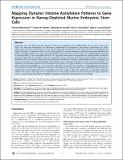| dc.contributor.author | Markowetz, Florian | |
| dc.contributor.author | Mulder, Klaas | |
| dc.contributor.author | Airoldi, Edoardo Maria | |
| dc.contributor.author | Lemischka, Ihor | |
| dc.contributor.author | Troyanskaya, Olga | |
| dc.date.accessioned | 2011-09-15T23:38:21Z | |
| dc.date.issued | 2010 | |
| dc.identifier.citation | Markowetz, Florian, Klaas W. Mulder, Edoardo M. Airoldi, Ihor R. Lemischka, and Olga G. Troyanskaya. 2010. Mapping dynamic histone acetylation patterns to gene expression in Nanog-depleted murine embryonic stem cells. PLoS Computational Biology 6(12): e1001034. | en_US |
| dc.identifier.issn | 1553-734X | en_US |
| dc.identifier.uri | http://nrs.harvard.edu/urn-3:HUL.InstRepos:5132919 | |
| dc.description.abstract | Embryonic stem cells (ESC) have the potential to self-renew indefinitely and to differentiate into any of the three germ layers. The molecular mechanisms for self-renewal, maintenance of pluripotency and lineage specification are poorly understood, but recent results point to a key role for epigenetic mechanisms. In this study, we focus on quantifying the impact of histone 3 acetylation (H3K9,14ac) on gene expression in murine embryonic stem cells. We analyze genome-wide histone acetylation patterns and gene expression profiles measured over the first five days of cell differentiation triggered by silencing Nanog, a key transcription factor in ESC regulation. We explore the temporal and spatial dynamics of histone acetylation data and its correlation with gene expression using supervised and unsupervised statistical models. On a genome-wide scale, changes in acetylation are significantly correlated to changes in mRNA expression and, surprisingly, this coherence increases over time. We quantify the predictive power of histone acetylation for gene expression changes in a balanced cross-validation procedure. In an in-depth study we focus on genes central to the regulatory network of Mouse ESC, including those identified in a recent genome-wide RNAi screen and in the PluriNet, a computationally derived stem cell signature. We find that compared to the rest of the genome, ESC-specific genes show significantly more acetylation signal and a much stronger decrease in acetylation over time, which is often not reflected in a concordant expression change. These results shed light on the complexity of the relationship between histone acetylation and gene expression and are a step toward dissecting the multilayer regulatory mechanisms that determine stem cell fate. | en_US |
| dc.description.sponsorship | Statistics | en_US |
| dc.language.iso | en_US | en_US |
| dc.publisher | Public Library of Science | en_US |
| dc.relation.isversionof | doi:10.1371/journal.pcbi.1001034 | en_US |
| dc.relation.hasversion | http://www.ncbi.nlm.nih.gov/pmc/articles/PMC3002996/ | en_US |
| dash.license | OAP | |
| dc.title | Mapping Dynamic Histone Acetylation Patterns to Gene Expression in Nanog-Depleted Murine Embryonic Stem Cells | en_US |
| dc.type | Journal Article | en_US |
| dc.description.version | Version of Record | en_US |
| dc.relation.journal | PLoS Computational Biology | en_US |
| dash.depositing.author | Airoldi, Edoardo Maria | |
| dc.date.available | 2011-09-15T23:38:21Z | |
| dc.identifier.doi | 10.1371/journal.pcbi.1001034 | * |
| dash.contributor.affiliated | Airoldi, Edoardo | |


